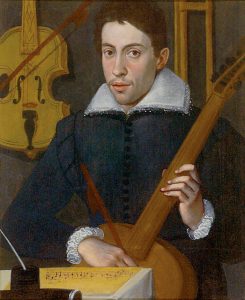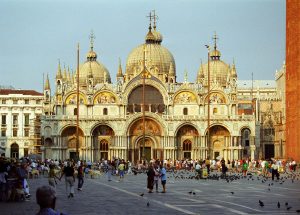
On August 19, 1613 – 406 years ago today – Claudio Monteverdi was appointed Maestro di Capella di San Marco: the director of music at Venice’s St. Mark’s Basilica. It was the gig of a lifetime!
There’s no doubt about it: Claudio Monteverdi was one of the very, very greatest composers, up there with that handful (give or take) of dead Austrian and German cats whose marble, plaster, and chalk busts grace our pianos and music rooms.
He was born in the northern Italian city of Cremona on May 15, 1567. Located on the north bank of the Po River in the middle of the Po Valley, Cremona is famous for its vegetable and olive oils, mustard, sweets, and preserved meats. However, Cremona’s most famous product is not its foodstuffs, yum-licious though they may be, but rather, the stringed instruments built there. It was in Cremona that the violin family of instruments was born and where some of the all-time greatest violin builders (or “luthiers”) plied their trade. Cremona was home to the Amati family and its greatest violin-building son, Nicolò Amati (1596-1684); home to the Guarneri family, and its greatest luthier, Giuseppe Guarneri del Gesù (1698-1744); finally, Cremona was the home of Antonio Stradivari (1644-1737).
The oldest surviving violin was built by Nicolò Amati’s grandfather, Andrea Amati (who lived from ca. 1520-ca. 1578). Known today as the “Charles IX” (because it bears the coat of arms of Charles IX of France), the violin was built in Cremona in 1564 (which was the same year William Shakespeare was born).

Claudio Giovanni Antonio Monteverdi was born in Cremona three years later. He was a musically gifted child, and at an early age, he developed into an excellent violinist. (Most appropriate for a native Cremonese!)
The outline of Monteverdi’s musical life can be stated quickly: he learned his craft in Cremona; he matured in Mantua; he flourished in Venice.
Monteverdi’s early musical education was supervised by Marc’Antonio Ingegneri, an important composer of the Counter-Reformation and the maestro di capella of Cremona. In 1582, at the age of fifteen, young Claudio had his first publication: a collection of three-part motets printed by the prestigious Venetian publishing house of Gardane. Further publications followed, underwritten by the various Cremonese patrons to whom they were dedicated, including his first book of madrigals (of an eventual five), which was published in 1587.
In 1590, at the age of 23, Monteverdi was hired on as a suonatore di vivuola – a string player – in the court of Vincenzo Gonzaga, Duke of Mantua. Monteverdi also composed for the Mantuan court, and he very quickly became one of Mantua’s leading musicians.
Monteverdi was an ambitious young man who longed for advancement. In May of 1601, when Benedetto Pallavicino, maestro di capella of Mantua, went into retirement, the 34-year-old Monteverdi was convinced that his time had come, and that the job was his. But six months passed, and no appointment was made. In November of 1601, Monteverdi – simmering, stewing, and finally boiling in his own juices – wrote a letter to the Duke, demanding to be appointed maestro di capella. It is an extraordinary letter, one that Monteverdi biographer Hans Ferdinand Redlich calls “a remarkably malicious document”. (Knowing what we know, today, about Monteverdi’s bad treatment there at Mantua, we would modify Herr Redlich’s evaluation and call the letter “a justifiably malicious letter.”) Over its course, Monteverdi points out that he has waited patiently for his many superiors to die off, and now that they were all dead, the job should be his:
“not just as a recompense for exceptional proficiency but as a reward for faithful and especial devotion such as I have always displayed in Your Highness’ service.”
The letter did the trick; Monteverdi was rewarded with the job of maestro di capella of Mantua. Unfortunately, it was a promotion he soon came to regret.
You Can Take This Job and Shove It
Even by the standards of the time, the Master of Music for the Court of Mantua had to work like a dog. For Monteverdi, who was a slow worker and a perfectionist, the pressure was debilitating. In a letter written to the Duke in 1604, the 37-year-old Monteverdi complained:
“I lack the energy to write as assiduously as I have in the past. For I still feel tired and weak from recent overwork. I beseech Your Highness now that, for the love of God, you never again give me so much to do at one time nor allow me so short a time to do it; otherwise, I shall have an unexpectedly short life instead of being able to serve Your Highness longer.”
Monteverdi’s attitude toward composing was surprisingly modern, perceiving it as more an art than a craft. At another time he wrote:
“If I have to write a lot in a short time, I shall be reduced to mere note-spinning instead of composing music appropriate to the text.”
In 1608, after having been required to set some 1500 verses to music on a short deadline, he wrote:
“I know one can compose fast, but ‘fast’ and ‘good’ do not go well together.”
The fact that Monteverdi’s salary at Mantua was disproportionately low for someone of his standing and with his responsibilities caused him great anxiety and made him as bitter as a wormwood sour with a toxic waste chaser. Monteverdi had a title, yes, but he became convinced that he was underpaid, under-appreciated, and wasting his best years in a place too small for his talents. He was correct on all three counts.

Things came to a head in 1608 as a result of both overwork and personal tragedy. On September 10, 1607, less than six months after the premiere of his first opera (and the first operatic masterwork) Orfeo, Monteverdi’s wife of 12 years, Claudia Cattaneo died, leaving him with two young sons, age two and seven. Monteverdi was disconsolate, and though he was to live for another 36 years, he never remarried.
In early 1608, Monteverdi – grieving, exhausted, and completely disgusted with the freakin’ Duke, with Mantua, and with his position – walked off the job, picked up his boys, and went home to Cremona. The Duke was not pleased with such insubordination from a hired flunky, and he ordered Monteverdi to return to Mantua. Monteverdi’s written response, addressed to the Duke’s councilor and treasurer Annibale Chieppo and dated December 2, 1608 is one of the most famous letters in the music literature. It reveals Monteverdi’s spirit, pride, and bitterness, and demonstrates that despite the fact that a composer was considered little more than a servant in the early seventeenth century, he knew his worth and demanded that he be treated with respect. It is a long letter, and we quote it only in part.
“Today I have received a letter from Your Honor from which I gather that His Highness commands me to hold myself in readiness to return to Mantua as soon as possible in order to tire myself out once again; at least, so he commands. I reply, that if I do not take a complete rest, my span of life will be shortened; for in consequence of my tremendous over-exertions in the past I have developed headaches and a severe, maddening rash on my body which neither the cauterizing I have undergone, nor the purgatives I have taken, nor even the bloodletting and other measures to which I have submitted have succeeded in curing more than partially.
I tell you, Your Honor, that the fortune I have enjoyed in Mantua throughout nineteen years has given me cause to feel ill-disposed rather than friendly.”
From here, Monteverdi goes on a lengthy screed protesting his financial treatment at the hands of the Duke. He closes the letter by writing:
“Now Your Honor will understand perfectly well how miserable I am in Mantua.”
At his father’s insistence, Monteverdi returned to Mantua, there to give it one last try. But when Duke Vincenzo died in February of 1612 and was succeeded by his son Francesco, Francesco fired Monteverdi almost immediately, on July 31, 1612.
(It was a stunning act of stupidity and ingratitude on the part of Francesco Gonzaga, on par with the Boston Red Sox owner Harry Frazee’s sale of Babe Ruth to the New York Yankees on January 20, 1920. Just like the subsequent “Curse of the Bambino” that saw the BoSox go from 1918 until 2004 without a World Series win, so there was a “Curse of the Monteverdi” to deal with there in Mantua: after ruling for just ten miserable months amid economic and political crises, both Francesco Gonzaga and his young son and heir died of smallpox.)
As it out, Francesco Gonzaga had done Monteverdi a huge favor. Monteverdi’s star was rising, and at the age of 45 he had an opportunity to test the market.

The timing could not have been better. On July 19, 1613, Don Giulio Cesare Martinengo, maestro di capella of the Basilica San Marco in Venice, died after a long illness. The clever officials at San Marco wasted not a moment. One month later, on August 19, 1613 – 406 years ago today – Monteverdi was brought to Venice and hired on the spot. Maestro di capella of the Basilica San Marco was not just the most prestigious musical position in all of Italy, but in all of Europe as well. Monteverdi was offered a generous salary of 300 ducats (which was soon raised to 400), a furnished apartment in the “Villa San Marco” free of charge, and a degree of artistic freedom he had never before experienced. Money, respect, comfort, and freedom; in a flash, Monteverdi had it all. And he got to live and work in Venice, for crying out loud: with all due respect, comparing Venice to Mantua is like comparing Paris, France to Trenton, N.J. (Having grown up near Trenton I know what I’m talking about here.)

Monteverdi and Venice were a terrific match. He remained Maestro de Capella of San Marco for 30 years, until his death in 1643. During that time, he composed a superb and varied body of music, both sacred and secular: masses, requiems, motets, polychoral compositions, and Vespers; operas and ballets for various northern Italian court theaters, madrigals for the aristocrats, and all sorts of occasional music for his wealthy Venetian friends and patrons.
(The only sour note in all of this bounty – and a sour note it is – is how much of Monteverdi’s music has been lost: a huge Requiem Mass about which only a description survives and which reportedly moved the entire audience to tears; at least half a dozen operas; Christmas masses; works lost to fires, rot, or simple negligence. Who knows: perhaps one of these pieces will turn up behind a bookshelf in a Venetian palazzo, or in an attic in Cremona or Mantua.)
For lots more on Monteverdi and his operas Orfeo and The Coronation of Poppaea, I would direct your attention to my Great Courses Survey, How to Listen to and Understand Great Opera, which can be examined and downloaded here at RobertGreenbergMusic.com.
Listen on the Music History Monday Podcast
Podcast: Play in new window
Subscribe: Apple Podcasts | Spotify | Pandora | iHeartRadio | RSS | More
